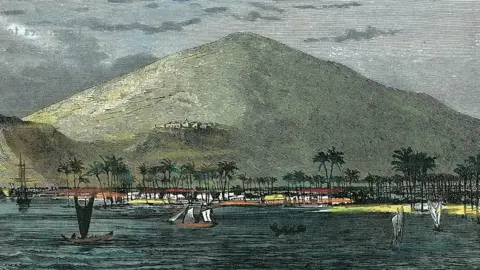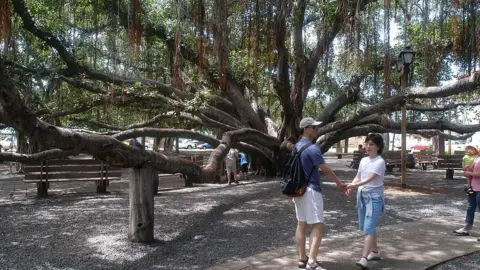Lahaina: Famous banyan tree and centuries-old church hit by fires
 Getty Images
Getty ImagesSites steeped in the history of Hawaii's royal past, a bustling art scene and the largest banyan tree in the US are just a few of the reasons Lahaina has long been a favourite tourist destination on the island of Maui.
More than two million people - about 80% of all Maui tourism - visit the town each year, attracted by beaches, restaurants and what the local town association calls "over a thousand years of rich history".
How much of that history remains standing after devastating and deadly fires swept across Maui, however, is still unclear.
While the scale of the destruction is still coming into focus, local officials have said that dozens of businesses have been destroyed, including much of the town's iconic Front Street. The town's historic harbour, the Lahaina Town Association said in an update, "is gone".
"They said the hurricane would go well south of the island, and that no one had to do anything. So nobody prepared," Theo Morrison, the executive director of the Lahaina Restoration Foundation, told the BBC. "Then the fire and the winds started and we were in trouble. It was a total surprise."
Lahaina - which in Hawaiian means "cruel sun", a reference to the area's hot, dry climate - has long been culturally and politically significant, with a history stretching back to long before the arrival of Europeans to Hawaii in 1778.
The first ruler of a unified Hawaii, Kamehameha the Great, conquered the area in 1795. Seven years later in 1802, Lahaina became the capital of the Hawaiian Kingdom, a position it held until 1845.
Within a few decades, Lahaina was also a hub for the world's whaling industry and home to a busy harbour that brought in missionaries and sailors from around the globe. Later on, in 1860, the area's first commercial sugar plantation began operating, marking the beginning of a local industry that lasted until 1999.
"It's probably one of the most significant places in Hawaiian history. This is where the kings and queens lived," said Ms Morrison, who was travelling to the UK when the fire struck. "It was a spiritual and cultural centre, and the first capital. It is super important... we take great pride in our history."
Until the recent fire, remnants of this past were everywhere in Lahaina.
The city's Baldwin Home, for example, housed some of the community's earliest missionaries and physicians. The nearby Halo Pa'ahao - Hawaiian for "stuck-in-irons house" - served as a jail for rowdy sailors in the city's whaling days. The city's old courthouse was a heritage museum, filled with artefacts from Hawaii's history.
Many of these attractions are now damaged or destroyed, along with large swathes of the town. Other reportedly destroyed sites include a 200-year-old church believed to be the first on Maui, and a nearby Buddhist temple built 90 years ago.
"We take care of 14 different sites, and all of them are heavily damaged, if not completely destroyed," Ms Morrison said. "The town corridor and all its historic wood buildings, those are all gone. So are people's houses, and the boats in the harbour. Most of them were commercial, like whale watching and dive boats. They all caught fire and sank. That really shocked me."
Among the buildings destroyed was the Baldwin home, which also housed the Ms Morrison's Lahaina Restoration Foundation and a small museum.
"The roof caught on fire and fell into the upper floor and destroyed our office," she said. "I'm assuming that it also fell onto the lower floor. The building basically has to be totally redone."
 Getty Images
Getty ImagesOf all Lahaina's sites, few are as well known as the town's 60ft (18m) tall, 46 trunk banyan tree, which covers an area of 1.94 acres (0.78 hectares) roughly the size of a city block. The tree was planted in 1873 on the site of Kamehameha the Great's first palace to mark 50 years of Lahaina's Protestant mission.
The banyan tree - which sits in a park taken care of by the Lahaina Restoration Foundation - celebrated its 150th birthday in April this year.
While its condition is unclear, images suggest that the tree has been burned but remains standing. The town's website suggested the tree will recover, saying that "if the roots are healthy, it will likely grow back".
"I tend to believe it'll be fine. It's really very hard to kill a banyan tree," Ms Morrison said. "I would be very surprised if it wasn't fine."
Others have warned that some of the damage to Lahaina may never be fixed.
"All the places there are tourist areas, that are Hawaiian history, are gone, and that can't be replaced," Richard Olson, a helicopter pilot who flew over Lahaina on Wednesday, told the Associated Press.
"You can't refurbish a building that's just ashes now," he added. "It can't be rebuilt - it's gone forever."
